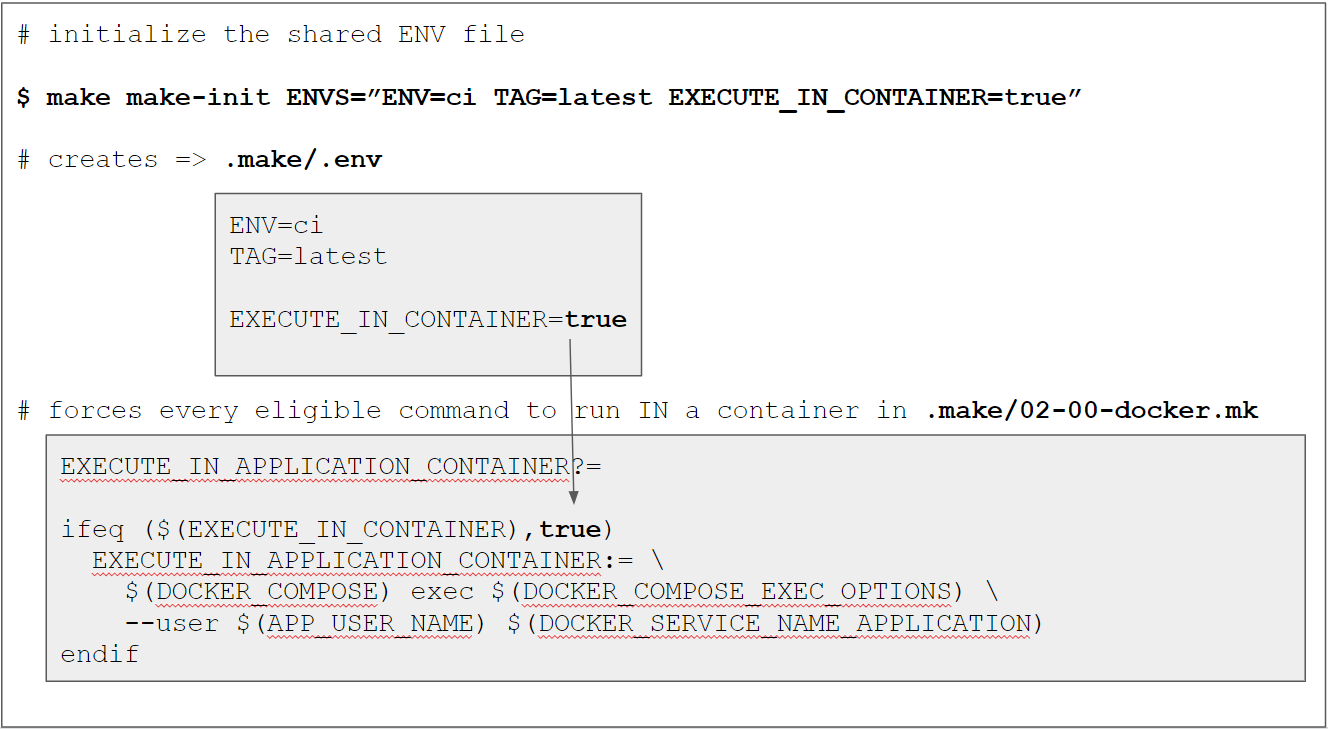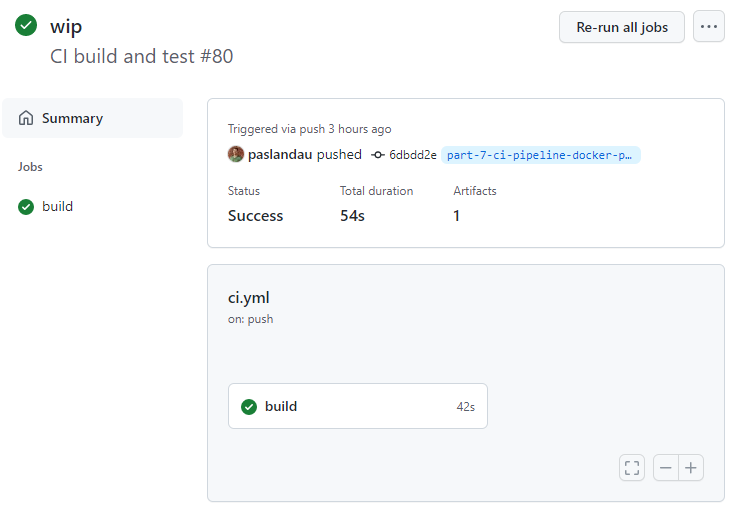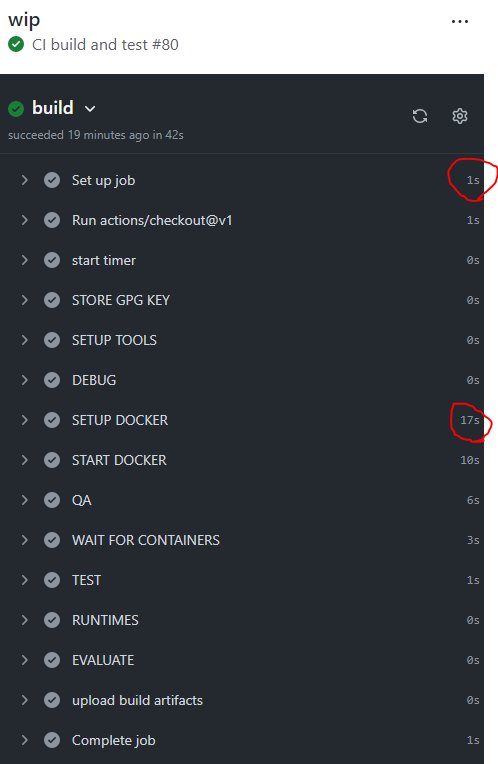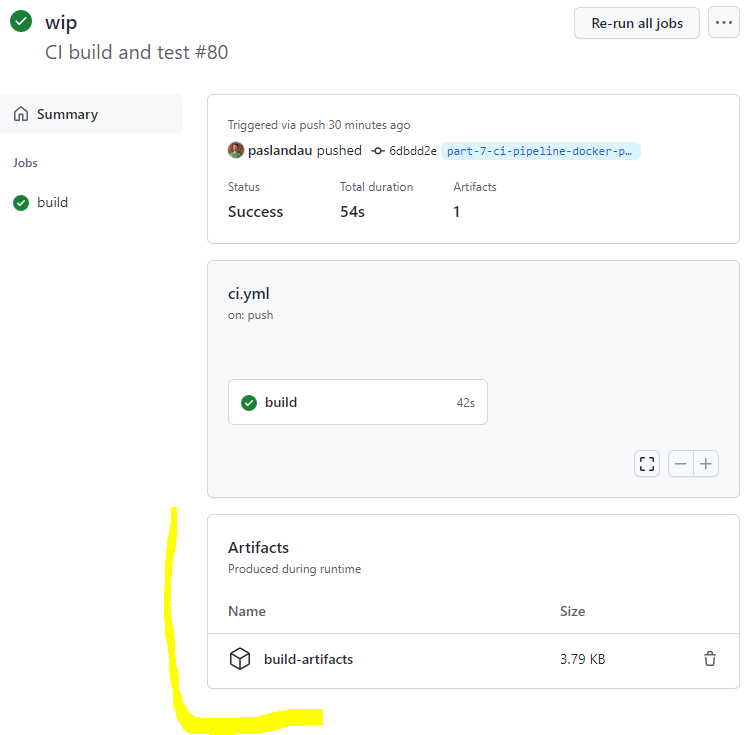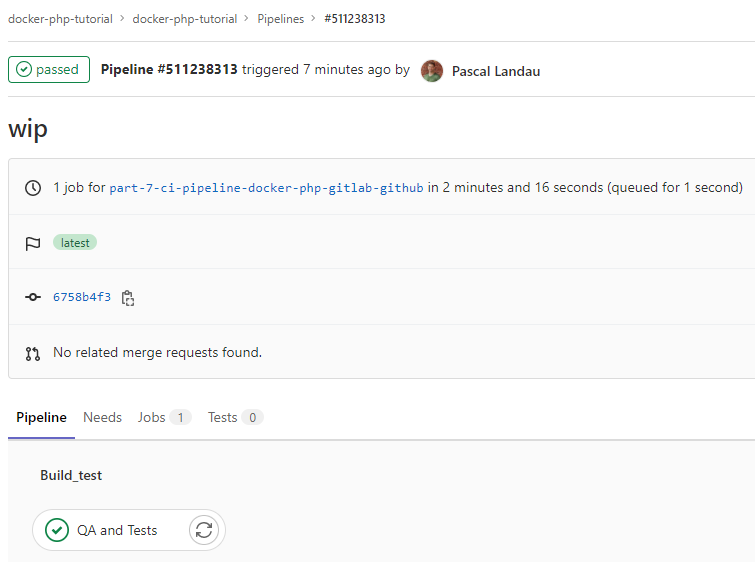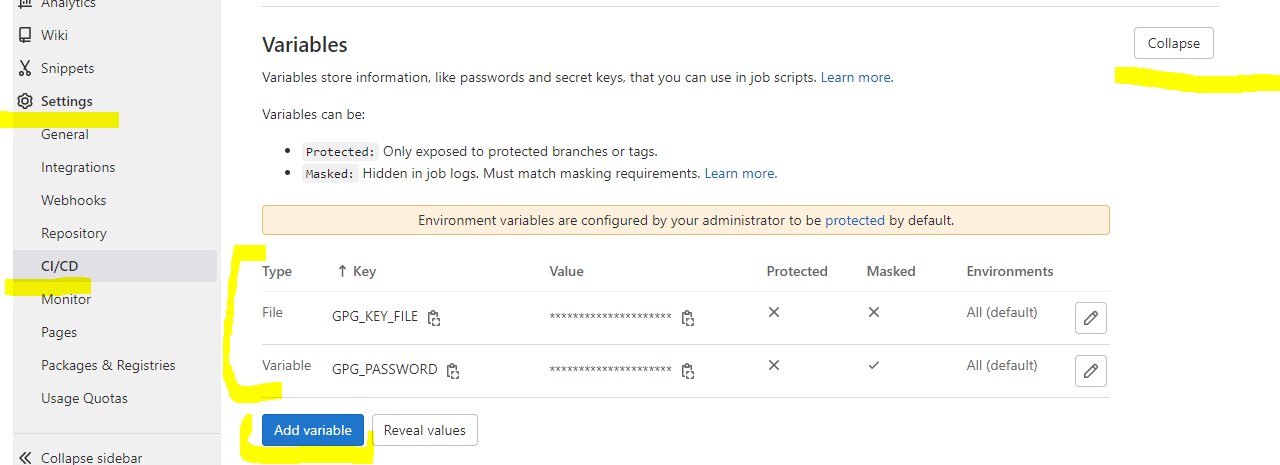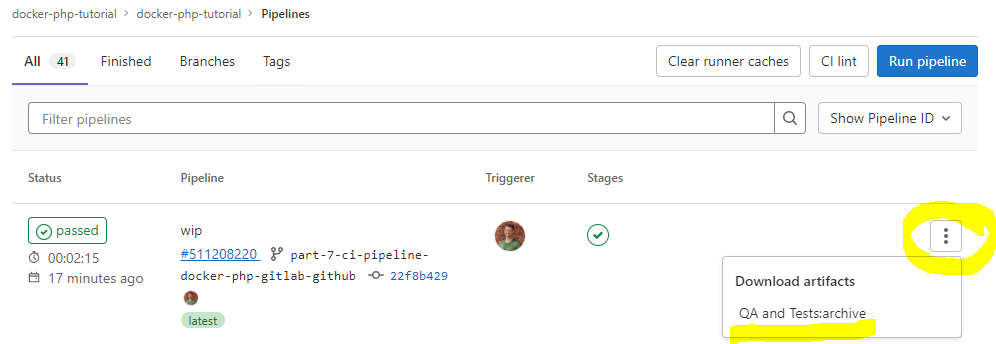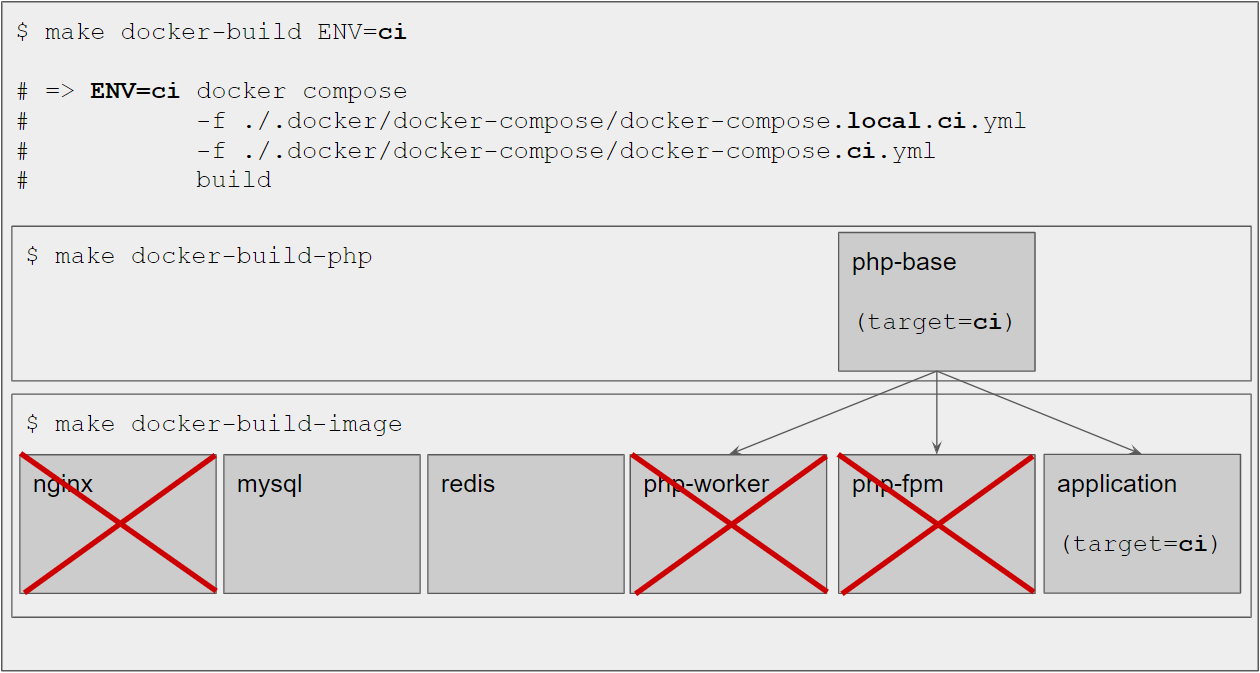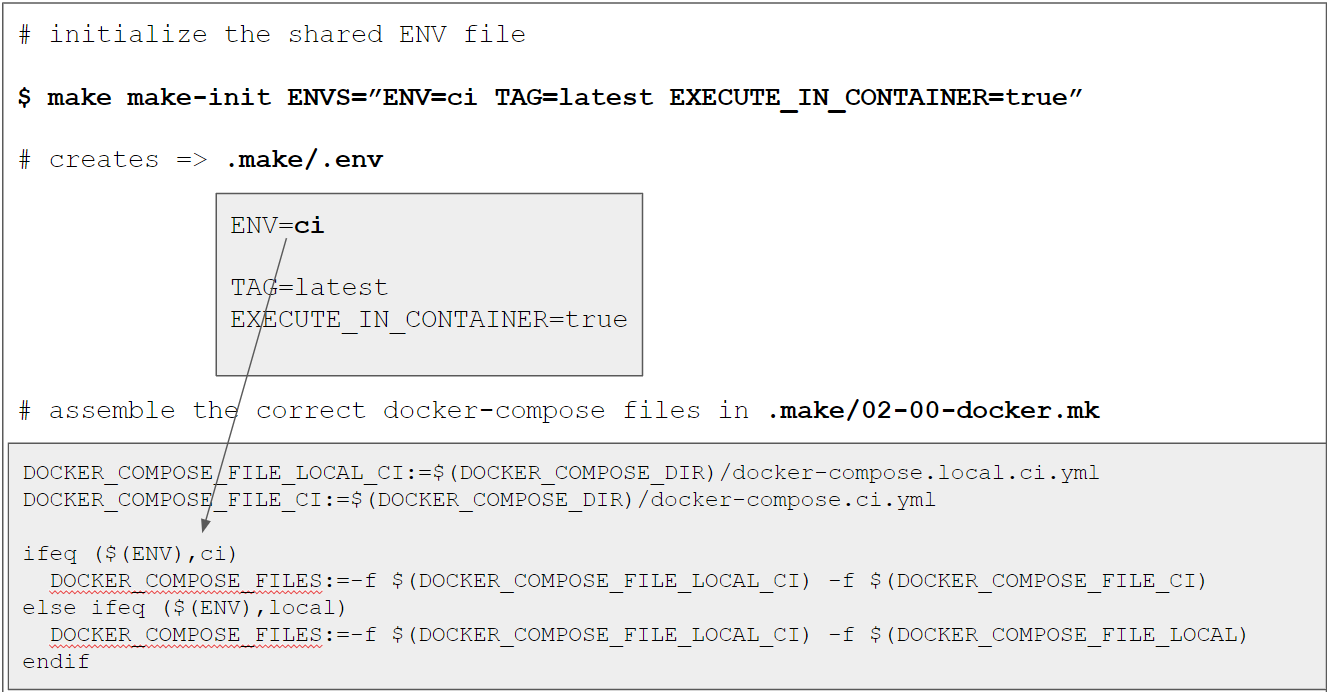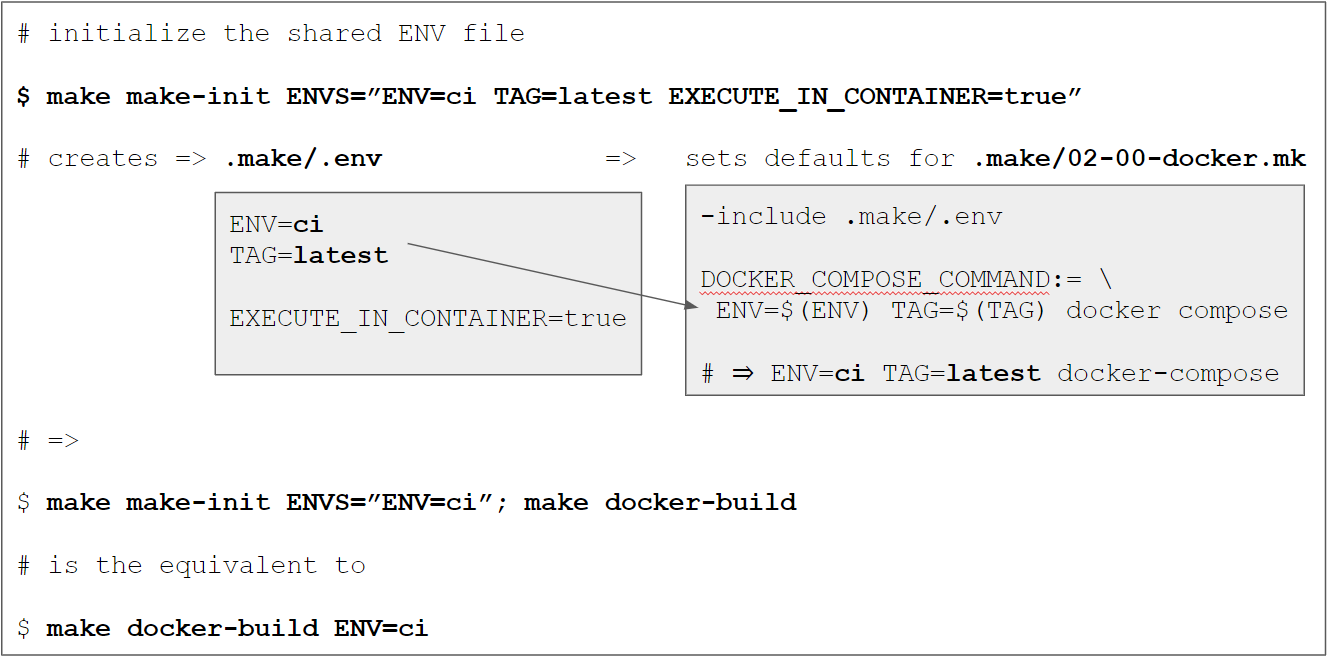In the seventh part of this tutorial series on developing PHP on Docker we will setup a CI
(Continuous Integration) pipeline to run code quality tools and tests on Github Actions and Gitlab
Pipelines.
All code samples are publicly available in my
Docker PHP Tutorial repository on github.
You find the branch for this tutorial at
part-7-ci-pipeline-docker-php-gitlab-github.
Published parts of the Docker PHP Tutorial
If you want to follow along, please subscribe to the RSS feed
or via email
to get automatic notifications when the next part comes out 🙂
Table of contents
Introduction
CI is short for Continuous Integration and to me mostly means running the code quality
tools and tests of a codebase in an isolated environment (preferably automatically). This is
particularly important when working in a team, because the CI system acts as the final
gatekeeper before features or bugfixes are merged into the main branch.
I initially learned about CI systems when I stubbed my toes into the open source water. Back in the
day I used Travis CI for my own projects and replaced it
with Github Actions at some point. At ABOUT YOU we started
out with a self-hosted Jenkins server and then moved on to
Gitlab CI as a fully
managed solution (though we use custom runners).
Recommended reading
This tutorial builds on top of the previous parts. I’ll do my best to cross-reference the
corresponding articles when necessary, but I would still recommend to do some upfront reading on:
And as a nice-to-know:
Approach
In this tutorial I’m going to explain how to make our existing docker setup work with Github Actions
and Gitlab CI/CD Pipelines. As I’m a big fan of a
“progressive enhancement” approach, we will ensure that all necessary steps can be performed
locally through make. This has the additional benefit of keeping a single source of truth (the
Makefile) which will come in handy when we set up the CI system on two different providers
(Github and Gitlab).
The general process will look very similar to the one for local development:
- build the docker setup
- start the docker setup
- run the qa tools
- run the tests
You can see the final results in the CI setup section, including the concrete yml
files and links to the repositories, see
On a code level, we will treat CI as an environment, configured through the env variable ENV. So
far we only used ENV=local and we will extend that to also use ENV=ci. The necessary changes
are explained after the concrete CI setup instructions in the sections
Try it yourself
To get a feeling for what’s going on, you can start by
executing the local CI run:
This should give you a similar output as presented in the Execution example.
git checkout part-7-ci-pipeline-docker-php-gitlab-github
# Initialize make
make make-init
# Execute the local CI run
bash .local-ci.shCI setup
General CI notes
Initialize make for CI
As a very first step we need to “configure” the codebase to operate for the ci environment.
This is done through the make-init target as explained later in more detail in the
Makefile changes section via
make make-init ENVS="ENV=ci TAG=latest EXECUTE_IN_CONTAINER=true GPG_PASSWORD=12345678"$ make make-init ENVS="ENV=ci TAG=latest EXECUTE_IN_CONTAINER=true GPG_PASSWORD=12345678"
Created a local .make/.env fileENV=ci ensures that we
TAG=latest is just a simplification for now because we don’t do anything with the images yet.
In an upcoming tutorial we will push them to a container registry for later usage in production
deployments and then set the TAG to something more meaningful (like the build number).
EXECUTE_IN_CONTAINER=true forces every make command that uses a
RUN_IN_*_CONTAINER setup
to run in a container. This is important, because the Gitlab runner will actually run in a
docker container itself. However, this would cause any affected target to omit the
$(DOCKER_COMPOSER) exec prefix.
GPG_PASSWORD=12345678 is the password for the secret gpg key as mentioned in
Add a password-protected secret gpg key.
wait-for-service.sh
I’ll explain the “container is up and running but the underlying service is not” problem
for the mysql service and how we can solve it with a health check later in this article at
Adding a health check for mysql.
On purpose, we don’t want docker compose to take care of the waiting because we can make
“better use of the waiting time” and will instead implement it ourselves with a simple bash
script located at .docker/scripts/wait-for-service.sh:
#!/bin/bash
name=$1
max=$2
interval=$3
[ -z "$1" ] && echo "Usage example: bash wait-for-service.sh mysql 5 1"
[ -z "$2" ] && max=30
[ -z "$3" ] && interval=1
echo "Waiting for service '$name' to become healthy, checking every $interval second(s) for max. $max times"
while true; do
((i++))
echo "[$i/$max] ...";
status=$(docker inspect --format "" "$(docker ps --filter name="$name" -q)")
if echo "$status" | grep -q '"healthy"'; then
echo "SUCCESS";
break
fi
if [ $i == $max ]; then
echo "FAIL";
exit 1
fi
sleep $interval;
doneThis script waits for a docker $service to become “healthy” by
checking the .State.Health.Status info
of the docker inspect command.
CAUTION: The script uses $(docker ps --filter name="$name" -q) to determine the id of the
container, i.e. it will “match” all running containers against the $name – this would fail if
there is more than one matching container! I.e. you must ensure that $name is specific
enough to identify one single container uniquely.
The script will check up to $max times
in a interval of $interval seconds. See these
answers on the
“How do I write a retry logic in script to keep retrying to run it up to 5 times?” question for
the implementation of the retry logic. To check the health of the mysql service for 5
times with 1 seconds between each try, it can be called via
bash wait-for-service.sh mysql 5 1Output
$ bash wait-for-service.sh mysql 5 1
Waiting for service 'mysql' to become healthy, checking every 1 second(s) for max. 5 times
[1/5] ...
[2/5] ...
[3/5] ...
[4/5] ...
[5/5] ...
FAIL
# OR
$ bash wait-for-service.sh mysql 5 1
Waiting for service 'mysql' to become healthy, checking every 1 second(s) for max. 5 times
[1/5] ...
[2/5] ...
SUCCESSThe problem of “container dependencies” isn’t new and there are already some existing solutions
out there, e.g.
But unfortunately all of them operate by checking the availability of a host:port combination
and in the case of mysql that didn’t help, because the container was up, the port was reachable
but the mysql service in the container was not.
Setup for a “local” CI run
As mentioned under Approach, we want to be able to perform all necessary steps
locally and I created a corresponding script at .local-ci.sh:
#!/bin/bash
# fail on any error
# @see https://stackoverflow.com/a/3474556/413531
set -e
make docker-down ENV=ci || true
start_total=$(date +%s)
# STORE GPG KEY
cp secret-protected.gpg.example secret.gpg
# DEBUG
docker version
docker compose version
cat /etc/*-release || true
# SETUP DOCKER
make make-init ENVS="ENV=ci TAG=latest EXECUTE_IN_CONTAINER=true GPG_PASSWORD=12345678"
start_docker_build=$(date +%s)
make docker-build
end_docker_build=$(date +%s)
mkdir -p .build && chmod 777 .build
# START DOCKER
start_docker_up=$(date +%s)
make docker-up
end_docker_up=$(date +%s)
make gpg-init
make secret-decrypt-with-password
# QA
start_qa=$(date +%s)
make qa || FAILED=true
end_qa=$(date +%s)
# WAIT FOR CONTAINERS
start_wait_for_containers=$(date +%s)
bash .docker/scripts/wait-for-service.sh mysql 30 1
end_wait_for_containers=$(date +%s)
# TEST
start_test=$(date +%s)
make test || FAILED=true
end_test=$(date +%s)
end_total=$(date +%s)
# RUNTIMES
echo "Build docker: " `expr $end_docker_build - $start_docker_build`
echo "Start docker: " `expr $end_docker_up - $start_docker_up `
echo "QA: " `expr $end_qa - $start_qa`
echo "Wait for containers: " `expr $end_wait_for_containers - $start_wait_for_containers`
echo "Tests: " `expr $end_test - $start_test`
echo "---------------------"
echo "Total: " `expr $end_total - $start_total`
# CLEANUP
# reset the default make variables
make make-init
make docker-down ENV=ci || true
# EVALUATE RESULTS
if [ "$FAILED" == "true" ]; then echo "FAILED"; exit 1; fi
echo "SUCCESS"Run details
- as a preparation step, we first ensure that no outdated
cicontainers are running (this is
only necessary locally, because runners on a remote CI system will start “from scratch”)make docker-down ENV=ci || true - we take some time measurements to understand how long certain parts take via
start_total=$(date +%s)to store the current timestamp
- we need the secret
gpgkey in order to decrypt the secrets and simply copy the
password-protected example key
(in the actual CI systems the key will be configured as a secret value that is injected in
the run)# STORE GPG KEY cp secret-protected.gpg.example secret.gpg - I like printing some debugging info in order to understand which exact circumstances
we’re dealing with (tbh, this is mostly relevant when setting the CI system up or making
modifications to it)# DEBUG docker version docker compose version cat /etc/*-release || true - for the docker setup, we start with
initializing the environment forci# SETUP DOCKER make make-init ENVS="ENV=ci TAG=latest EXECUTE_IN_CONTAINER=true GPG_PASSWORD=12345678"then build the docker setup
make docker-buildand finally add a
.build/directory to
collect the build artifactsmkdir -p .build && chmod 777 .build - then, the docker setup is started
# START DOCKER make docker-upand
gpgis initialized so that
the secrets can be decryptedmake gpg-init make secret-decrypt-with-passwordWe don’t need to pass a
GPG_PASSWORDtosecret-decrypt-with-passwordbecause we have set
it up in the previous step as a default value viamake-init - once the
applicationcontainer is running, the qa tools are run by invoking the
qamake target# QA make qa || FAILED=trueThe
|| FAILED=truepart makes sure that the script will not be terminated if the checks fail.
Instead, the fact that a failure happened is “recorded” in theFAILEDvariable so that we
can evaluate it at the end. We don’t want the script to stop here because we want the
following steps to be executed as well (e.g. the tests). - to mitigate the
“mysqlis not ready” problem, we will now apply the
wait-for-service.sh script# WAIT FOR CONTAINERS bash .docker/scripts/wait-for-service.sh mysql 30 1 - once
mysqlis ready, we can execute the tests via the
testmake target and
apply the same|| FAILED=trueworkaround as for the qa tools# TEST make test || FAILED=true - finally, all the timers are printed
# RUNTIMES echo "Build docker: " `expr $end_docker_build - $start_docker_build` echo "Start docker: " `expr $end_docker_up - $start_docker_up ` echo "QA: " `expr $end_qa - $start_qa` echo "Wait for containers: " `expr $end_wait_for_containers - $start_wait_for_containers` echo "Tests: " `expr $end_test - $start_test` echo "---------------------" echo "Total: " `expr $end_total - $start_total` - we clean up the resources (this is only necessary when running locally, because the runner of
a CI system would be shut down anyways)# CLEANUP make make-init make docker-down ENV=ci || true -
and finally evaluate if any error occurred when running the qa tools or the tests
# EVALUATE RESULTS if [ "$FAILED" == "true" ]; then echo "FAILED"; exit 1; fi echo "SUCCESS"
Execution example
Executing the script via
bash .local-ci.shyields the following (shortened) output:
$ bash .local-ci.sh
Container dofroscra_ci-redis-1 Stopping
# Stopping all other `ci` containers ...
# ...
Client:
Cloud integration: v1.0.22
Version: 20.10.13
# Print more debugging info ...
# ...
Created a local .make/.env file
ENV=ci TAG=latest DOCKER_REGISTRY=docker.io DOCKER_NAMESPACE=dofroscra APP_USER_NAME=application APP_GROUP_NAME=application docker compose -p dofroscra_ci --env-file ./.docker/.env -f ./.docker/docker-compose/docker-compose-php-base.yml build php-base
#1 [internal] load build definition from Dockerfile
# Output from building the docker containers
# ...
ENV=ci TAG=latest DOCKER_REGISTRY=docker.io DOCKER_NAMESPACE=dofroscra APP_USER_NAME=application APP_GROUP_NAME=application docker compose -p dofroscra_ci --env-file ./.docker/.env -f ./.docker/docker-compose/docker-compose.local.ci.yml -f ./.docker/docker-compose/docker-compose.ci.yml up -d
Network dofroscra_ci_network Creating
# Starting all `ci` containers ...
# ...
"C:/Program Files/Git/mingw64/bin/make" -s gpg-import GPG_KEY_FILES="secret.gpg"
gpg: directory '/home/application/.gnupg' created
gpg: keybox '/home/application/.gnupg/pubring.kbx' created
gpg: /home/application/.gnupg/trustdb.gpg: trustdb created
gpg: key D7A860BBB91B60C7: public key "Alice Doe protected <[email protected]>" imported
# Output of importing the secret and public gpg keys
# ...
"C:/Program Files/Git/mingw64/bin/make" -s git-secret ARGS="reveal -f -p 12345678"
git-secret: done. 1 of 1 files are revealed.
"C:/Program Files/Git/mingw64/bin/make" -j 8 -k --no-print-directory --output-sync=target qa-exec NO_PROGRESS=true
phplint done took 4s
phpcs done took 4s
phpstan done took 8s
composer-require-checker done took 8s
Waiting for service 'mysql' to become healthy, checking every 1 second(s) for max. 30 times
[1/30] ...
SUCCESS
PHPUnit 9.5.19 #StandWithUkraine
........ 8 / 8 (100%)
Time: 00:03.077, Memory: 28.00 MB
OK (8 tests, 15 assertions)
Build docker: 12
Start docker: 2
QA: 9
Wait for containers: 3
Tests: 5
---------------------
Total: 46
Created a local .make/.env file
Container dofroscra_ci-application-1 Stopping
Container dofroscra_ci-mysql-1 Stopping
# Stopping all other `ci` containers ...
# ...
SUCCESSSetup for Github Actions
If you are completely new to Github Actions, I recommend to start with the
official Quickstart Guide for GitHub Actions
and the
Understanding GitHub Actions
article. In short:
- Github Actions are based on so called Workflows
- Workflows are
yamlfiles that live in the special.github/workflowsdirectory in the
repository
- Workflows are
- a Workflow can contain multiple Jobs
- each Job consists of a series of Steps
- each Step needs a
run:element that represents a command that is executed by a new shell
The Workflow file
Github Actions are triggered automatically based on the files in the .github/workflows directory.
I have added the file .github/workflows/ci.yml with the following content:
name: CI build and test
on:
# automatically run for pull request and for pushes to branch "part-7-ci-pipeline-docker-php-gitlab-github"
# @see https://stackoverflow.com/a/58142412/413531
push:
branches:
- part-7-ci-pipeline-docker-php-gitlab-github
pull_request: {}
# enable to trigger the action manually
# @see https://github.blog/changelog/2020-07-06-github-actions-manual-triggers-with-workflow_dispatch/
# CAUTION: there is a known bug that makes the "button to trigger the run" not show up
# @see https://github.community/t/workflow-dispatch-workflow-not-showing-in-actions-tab/130088/29
workflow_dispatch: {}
jobs:
build:
runs-on: ubuntu-latest
steps:
- uses: actions/[email protected]
- name: start timer
run: |
echo "START_TOTAL=$(date +%s)" > $GITHUB_ENV
- name: STORE GPG KEY
run: |
# Note: make sure to wrap the secret in double quotes (")
echo "$" > ./secret.gpg
- name: SETUP TOOLS
run : |
DOCKER_CONFIG=${DOCKER_CONFIG:-$HOME/.docker}
# install docker compose
# @see https://docs.docker.com/compose/cli-command/#install-on-linux
# @see https://github.com/docker/compose/issues/8630#issuecomment-1073166114
mkdir -p $DOCKER_CONFIG/cli-plugins
curl -sSL https://github.com/docker/compose/releases/download/v2.2.3/docker-compose-linux-$(uname -m) -o $DOCKER_CONFIG/cli-plugins/docker-compose
chmod +x $DOCKER_CONFIG/cli-plugins/docker-compose
- name: DEBUG
run: |
docker compose version
docker --version
cat /etc/*-release
- name: SETUP DOCKER
run: |
make make-init ENVS="ENV=ci TAG=latest EXECUTE_IN_CONTAINER=true GPG_PASSWORD=$"
make docker-build
mkdir .build && chmod 777 .build
- name: START DOCKER
run: |
make docker-up
make gpg-init
make secret-decrypt-with-password
- name: QA
run: |
# Run the tests and qa tools but only store the error instead of failing immediately
# @see https://stackoverflow.com/a/59200738/413531
make qa || echo "FAILED=qa" >> $GITHUB_ENV
- name: WAIT FOR CONTAINERS
run: |
# We need to wait until mysql is available.
bash .docker/scripts/wait-for-service.sh mysql 30 1
- name: TEST
run: |
make test || echo "FAILED=test $FAILED" >> $GITHUB_ENV
- name: RUNTIMES
run: |
echo `expr $(date +%s) - $START_TOTAL`
- name: EVALUATE
run: |
# Check if $FAILED is NOT empty
if [ ! -z "$FAILED" ]; then echo "Failed at $FAILED" && exit 1; fi
- name: upload build artifacts
uses: actions/[email protected]
with:
name: build-artifacts
path: ./.buildThe steps are essentially the same as explained before at
Run details for the local run. Some additional notes:
- I want the Action to be triggered automatically only when I
push to branchpart-7-ci-pipeline-docker-php-gitlab-github
OR when a pull request is created (viapull_request). In addition, I want to be able to
trigger the Action manually on any branch
(viaworkflow_dispatch).on: push: branches: - part-7-ci-pipeline-docker-php-gitlab-github pull_request: {} workflow_dispatch: {}For a real project, I would let the action only run automatically on long-living branches like
mainordevelop. The manual trigger is helpful if you just want to test your current work
without putting it up for review. CAUTION: There is a
known issue that “hides” the “Trigger workflow” button to trigger the action manually. - a new shell is started for each
run:instruction, thus we must store our timer in the “global”
environment variable$GITHUB_ENV- name: start timer run: | echo "START_TOTAL=$(date +%s)" > $GITHUB_ENVThis will be the only timer we use, because the job uses multiple steps that are timed
automatically – so we don’t need to take timestamps manually:
-
the
gpgkey is configured as an
encrypted secret named
GPG_KEYand is stored in./secret.gpg. The value is the content of the
secret-protected.gpg.examplefile- name: STORE GPG KEY run: | echo "$" > ./secret.gpgSecrets are configured in the Github repository under
Settings > Secrets > Actionsathttps://github.com/$user/$repository/settings/secrets/actions e.g. https://github.com/paslandau/docker-php-tutorial/settings/secrets/actions - the
ubuntu-latestimage doesn’t contain thedocker composeplugin, thus we need to
install it manually- name: SETUP TOOLS run : | DOCKER_CONFIG=${DOCKER_CONFIG:-$HOME/.docker} mkdir -p $DOCKER_CONFIG/cli-plugins curl -sSL https://github.com/docker/compose/releases/download/v2.2.3/docker-compose-linux-$(uname -m) -o $DOCKER_CONFIG/cli-plugins/docker-compose chmod +x $DOCKER_CONFIG/cli-plugins/docker-compose - for the
makeinitialization we need the second secret namedGPG_PASSWORD– which is
configured as12345678in our case, see
Add a password-protected secret gpg key- name: SETUP DOCKER run: | make make-init ENVS="ENV=ci TAG=latest EXECUTE_IN_CONTAINER=true GPG_PASSWORD=$" - because the runner will be shutdown after the run, we need to move the build artifacts to a
permanent location, using the
actions/[email protected] action- name: upload build artifacts uses: actions/[email protected] with: name: build-artifacts path: ./.build
Setup for Gitlab Pipelines
If you are completely new to Gitlab Pipelines, I recommend to start with the
official Get started with GitLab CI/CD guide. In
short:
- the core concept of Gitlab Pipelines is the Pipeline
- it is defined in the
yamlfile.gitlab-ci.ymlthat lives in the root of the repository
- it is defined in the
- a Pipeline can contain multiple Stages
- each Stage consists of a series of Jobs
- each Job contains a
scriptsection - the
scriptsection consists of a series of shell commands
The .gitlab-ci.yml pipeline file
Gitlab Pipelines are triggered automatically based on a .gitlab-ci.yml file located at the
root of the repository. It has the following content:
stages:
- build_test
QA and Tests:
stage: build_test
rules:
# automatically run for pull request and for pushes to branch "part-7-ci-pipeline-docker-php-gitlab-github"
- if: '($CI_PIPELINE_SOURCE == "merge_request_event" || $CI_COMMIT_BRANCH == "part-7-ci-pipeline-docker-php-gitlab-github")'
# see https://docs.gitlab.com/ee/ci/docker/using_docker_build.html#use-docker-in-docker
image: docker:20.10.12
services:
- name: docker:dind
script:
- start_total=$(date +%s)
## STORE GPG KEY
- cp $GPG_KEY_FILE ./secret.gpg
## SETUP TOOLS
- start_install_tools=$(date +%s)
# "curl" is required to download docker compose
- apk add --no-cache make bash curl
# install docker compose
# @see https://docs.docker.com/compose/cli-command/#install-on-linux
- mkdir -p ~/.docker/cli-plugins/
- curl -sSL https://github.com/docker/compose/releases/download/v2.2.3/docker-compose-linux-x86_64 -o ~/.docker/cli-plugins/docker-compose
- chmod +x ~/.docker/cli-plugins/docker-compose
- end_install_tools=$(date +%s)
## DEBUG
- docker version
- docker compose version
# show linux distro info
- cat /etc/*-release
## SETUP DOCKER
# Pass default values to the make-init command - otherwise we would have to pass those as arguments to every make call
- make make-init ENVS="ENV=ci TAG=latest EXECUTE_IN_CONTAINER=true GPG_PASSWORD=$GPG_PASSWORD"
- start_docker_build=$(date +%s)
- make docker-build
- end_docker_build=$(date +%s)
- mkdir .build && chmod 777 .build
## START DOCKER
- start_docker_up=$(date +%s)
- make docker-up
- end_docker_up=$(date +%s)
- make gpg-init
- make secret-decrypt-with-password
## QA
# Run the tests and qa tools but only store the error instead of failing immediately
# @see https://stackoverflow.com/a/59200738/413531
- start_qa=$(date +%s)
- make qa ENV=ci || FAILED=true
- end_qa=$(date +%s)
## WAIT FOR CONTAINERS
# We need to wait until mysql is available.
- start_wait_for_containers=$(date +%s)
- bash .docker/scripts/wait-for-service.sh mysql 30 1
- end_wait_for_containers=$(date +%s)
## TEST
- start_test=$(date +%s)
- make test ENV=ci || FAILED=true
- end_test=$(date +%s)
- end_total=$(date +%s)
# RUNTIMES
- echo "Tools:" `expr $end_install_tools - $start_install_tools`
- echo "Build docker:" `expr $end_docker_build - $start_docker_build`
- echo "Start docker:" `expr $end_docker_up - $start_docker_up `
- echo "QA:" `expr $end_qa - $start_qa`
- echo "Wait for containers:" `expr $end_wait_for_containers - $start_wait_for_containers`
- echo "Tests:" `expr $end_test - $start_test`
- echo "Total:" `expr $end_total - $start_total`
# EVALUATE RESULTS
# Use if-else constructs in Gitlab pipelines
# @see https://stackoverflow.com/a/55464100/413531
- if [ "$FAILED" == "true" ]; then exit 1; fi
# Save the build artifact, e.g. the JUNIT report.xml file, so we can download it later
# @see https://docs.gitlab.com/ee/ci/pipelines/job_artifacts.html
artifacts:
when: always
paths:
# the quotes are required
# @see https://stackoverflow.com/questions/38009869/how-to-specify-wildcard-artifacts-subdirectories-in-gitlab-ci-yml#comment101411265_38055730
- ".build/*"
expire_in: 1 weekThe steps are essentially the same as explained before under
Run details for the local run. Some additional notes:
- we start by defining the stages of the pipeline – though that’s currently just one (
build_test)stages: - build_test - then we define the job
QA and Testsand assign it to thebuild_teststageQA and Tests: stage: build_test - I want the Pipeline to be triggered automatically only when I
push to branchpart-7-ci-pipeline-docker-php-gitlab-github
OR when a pull request is created
Triggering the Pipeline manually on any branch is possible by default.rules: - if: '($CI_PIPELINE_SOURCE == "merge_request_event" || $CI_COMMIT_BRANCH == "part-7-ci-pipeline-docker-php-gitlab-github")' -
since we want to build and run docker images, we need to use a docker base image and activate the
docker:dindservice. See Use Docker to build Docker images: Use Docker-in-Dockerimage: docker:20.10.12 services: - name: docker:dind -
we store the secret
gpgkey as a secret file (using the
“file” type) in the
CI/CD variables configuration of the Gitlab repository
and move it to./secret.gpgin order to decrypt the secrets later## STORE GPG KEY - cp $GPG_KEY_FILE ./secret.gpgSecrets can be configured under
Settings > CI/CD > Variablesathttps://gitlab.com/$project/$repository/-/settings/ci_cd e.g. https://gitlab.com/docker-php-tutorial/docker-php-tutorial/-/settings/ci_cd - the docker base image doesn’t come with all required tools, thus we need to install the
missing ones (make,bash,curlanddocker compose)## SETUP TOOLS - apk add --no-cache make bash curl - mkdir -p ~/.docker/cli-plugins/ - curl -sSL https://github.com/docker/compose/releases/download/v2.2.3/docker-compose-linux-x86_64 -o ~/.docker/cli-plugins/docker-compose - chmod +x ~/.docker/cli-plugins/docker-compose - for the initialization of
makewe use the$GPG_PASSWORDvariable that we defined in the
CI/CD settings## SETUP DOCKER - make make-init ENVS="ENV=ci TAG=latest EXECUTE_IN_CONTAINER=true GPG_PASSWORD=$GPG_PASSWORD"Note: I have marked the variable as “masked”
so it won’t show up in any logs - finally, we store the job artifacts
artifacts: when: always paths: - ".build/*" expire_in: 1 weekThey can be accessed in the Pipeline overview UI
Performance
Performance isn’t an issue right now, because the CI runs take only about ~1 min (Github Actions)
and ~2 min (Gitlab Pipelines), but that’s mostly because we only ship a super minimal
application and those times will go up when things get more complex. For the local setup I
used all 8 cores of my laptop. The time breakdown is roughly as follows:
| Step | Gitlab | Github | local without cache |
local with cached images |
local with cached images + layers |
|---|---|---|---|---|---|
| SETUP TOOLS | 1 | 0 | 0 | 0 | 0 |
| SETUP DOCKER | 33 | 17 | 39 | 39 | 5 |
| START DOCKER | 17 | 11 | 34 | 2 | 1 |
| QA | 17 | 5 | 10 | 13 | 1 |
| WAIT FOR CONTAINERS | 5 | 5 | 3 | 2 | 13 |
| TESTS | 3 | 1 | 3 | 6 | 3 |
| total (excl. runner startup) |
78 | 43 | 97 | 70 | 36 |
| total (incl. runner startup) |
139 | 54 | 97 | 70 | 36 |
Times taken from
Optimizing the performance is out of scope for this tutorial, but I’ll at least document my
current findings.
The caching problem on CI
A good chunk of time is usually spent on building the docker images. We did our best to optimize
the process by leveraging the layer cache and using cache mounts
(see section Build stage ci in the php-base image).
But those steps are futile on CI systems, because the corresponding runners will start “from
scratch” for every CI run – i.e. there is no local cache that they could use. In
consequence, the full docker setup is also built “from scratch” on every run.
There are ways to mitigate that e.g.
But: None of that worked for me out-of-the-box 🙁 We will take a closer look in an upcoming
tutorial. Some reading material that I found valuable so far:
Docker changes
As a first step we need to decide which containers are required and how to provide the
codebase.
Since our goal is running the qa tools and tests, we only need the application php container. The
tests also need a database and a queue, i.e. the mysql and redis containers are required as
well – whereas nginx, php-fpm and php-worker are not required. We’ll handle that through
dedicated docker compose configuration files that only contain the necessary services. This is
explained in more detail in section Compose file updates.
In our local setup, we have shared the codebase between the host system and docker – mainly
because we wanted our changes to be reflected immediately in docker. This isn’t necessary for the
CI use case. In fact we want our CI images as close as possible to our production images – and
those should “contain everything to run independently”. I.e. the codebase should live in the
image – not on the host system. This will be explained in section
Use the whole codebase as build context.
Compose file updates
We will not only have some differences between the CI docker setup and the local docker setup
(=different containers), but also in the configuration of the individual services. To accommodate
for that, we will use the following docker compose config files in the
.docker/docker-compose/ directory:
docker-compose.local.ci.yml:- holds configuration that is valid for
localandci, trying to keep the config files
DRY
- holds configuration that is valid for
docker-compose.ci.yml:- holds configuration that is only valid for
ci
- holds configuration that is only valid for
docker-compose.local.yml:- holds configuration that is only valid for
local
- holds configuration that is only valid for
When using docker compose we then need to make sure to include only the required files, e.g. for
ci:
docker compose -f docker-compose.local.ci.yml -f docker-compose.ci.ymlI’ll explain the logic for that later in
section ENV based docker compose config. In short:
When comparing ci with local, for ci
- we don’t need to share the codebase with the host system
application: volumes: - ${APP_CODE_PATH_HOST?}:${APP_CODE_PATH_CONTAINER?} -
we don’t need persistent volumes for the redis and mysql data
mysql: volumes: - mysql:/var/lib/mysql redis: volumes: - redis:/data -
we don’t need to share ports with the host system
application: ports: - "${APPLICATION_SSH_HOST_PORT:-2222}:22" redis: ports: - "${REDIS_HOST_PORT:-6379}:6379" - we don’t need any settings for local dev tools like
xdebugorstraceapplication: environment: - PHP_IDE_CONFIG=${PHP_IDE_CONFIG?} cap_add: - "SYS_PTRACE" security_opt: - "seccomp=unconfined" extra_hosts: - host.docker.internal:host-gateway
So all of those config values will only live in the docker-compose.local.yml file. In fact, there
are only two things that ci needs that local doesn’t:
- a volume mount to share only the secret gpg key from the host with the
applicationcontainerapplication: volumes: - ${APP_CODE_PATH_HOST?}/secret.gpg:${APP_CODE_PATH_CONTAINER?}/secret.gpg:roThis
is required to decrypt the secrets:[…] the private key has to be named
secret.gpgand put in the root of the codebase,
so that the import can be be simplified withmaketargets - a volume mount to share a
.buildfolder for build artifacts with theapplicationcontainerapplication: volumes: - ${APP_CODE_PATH_HOST?}/.build:${APP_CODE_PATH_CONTAINER?}/.buildThis will be used to collect any files we want to retain from a build (e.g. code coverage
information, log files, etc.)
Adding a health check for mysql
When running the tests for the first time on a CI system, I noticed some weird errors related to the
database:
1) Tests\Feature\App\Http\Controllers\HomeControllerTest::test___invoke with data set "default" (array(), ' <li><a href="?dispatch=fo...></li>')
PDOException: SQLSTATE[HY000] [2002] Connection refusedAs it turned out, the mysql container itself was up and running – but the mysql process
within the container was not yet ready to accept connections. Locally, this hasn’t been a problem,
because we usually would not run the tests “immediately” after starting the containers – but on CI
this is the case.
Fortunately, docker compose has us covered here and provides a
healtcheck configuration option:
healthcheckdeclares a check that’s run to determine whether or not containers for this service are “healthy”.
Since this healthcheck is also “valid” for local, I defined it in the combined
docker-compose.local.ci.yml file:
mysql:
healthcheck:
# Only mark the service as healthy if mysql is ready to accept connections
# Check every 2 seconds for 30 times, each check has a timeout of 1s
test: mysqladmin ping -h 127.0.0.1 -u $$MYSQL_USER --password=$$MYSQL_PASSWORD
timeout: 1s
retries: 30
interval: 2sThe script in test was taken
from SO: Docker-compose check if mysql connection is ready.
When starting the docker setup, docker ps will now add a health info to the STATUS:
$ make docker-up
$ docker ps
CONTAINER ID IMAGE STATUS NAMES
b509eb2f99c0 dofroscra/application-ci:latest Up 1 seconds dofroscra_ci-application-1
503e52fd9e68 mysql:8.0.28 Up 1 seconds (health: starting) dofroscra_ci-mysql-1
# a couple of seconds later
$ docker ps
CONTAINER ID IMAGE STATUS NAMES
b509eb2f99c0 dofroscra/application-ci:latest Up 13 seconds dofroscra_ci-application-1
503e52fd9e68 mysql:8.0.28 Up 13 seconds (healthy) dofroscra_ci-mysql-1Note the (health: starting) and (healthy) infos for the mysql service.
We can also get this info from docker inspect (used by our
wait-for-service.sh script) via:
$ docker inspect --format "" dofroscra_ci-mysql-1
"healthy"FYI: We could also use the
depends_on property with a
condition: service_healthy on the application container so that docker compose would
only start the container once the mysql service is healthy:
application:
depends_on:
mysql:
condition: service_healthyHowever, this would “block” the make docker-up until mysql is actually up and running. In
our case this is not desirable, because we can do “other stuff” in the meantime (namely: run the
qa checks, because they don’t require a database) and thus save a couple of seconds on each CI
run.
Build target: ci
We’ve already introduced build targets in
Environments and build targets
and how to “choose”
them through make with the ENV variable defined in a shared .make/.env file.
Short recap:
- in the
Dockerfileof a service, define theENVas a build stage. E.g. in
.docker/images/php/base/DockerfileFROM base as ci # ...
So to enable the new ci environment, we need to modify the Dockerfiles for the php-base and
the application image.
Build stage ci in the php-base image
Use the whole codebase as build context
As mentioned in section Docker changes we want to “bake” the codebase into
the ci image of the php-base container. Thus, we must change the context property in
.docker/docker-compose/docker-compose-php-base.yml to not only use the .docker/ directory
but instead the whole codebase. I.e. “dont use ../ but ../../“:
# File: .docker/docker-compose/docker-compose-php-base.yml
php-base:
build:
# pass the full codebase to docker for building the image
context: ../../Build the dependencies
The composer dependencies must be set up in the image as well, so we introduce a new stage
stage in .docker/images/php/base/Dockerfile. The most trivial solution would look like this:
- copy the whole codebase
- run
composer install
FROM base as ci
COPY . /codebase
RUN composer install --no-scripts --no-plugins --no-progress -oHowever, this approach has some downsides:
- if any file in the codebase changes, the
COPY . /codebaselayer will be invalidated. I.e.
docker could not use the layer cache
which also means that every layer afterwards cannot use the cache as well. In consequence the
composer installwould run every time – even when thecomposer.jsonfile doesn’t change. composeritself uses a cache for
storing dependencies locally so it doesn’t have to download dependencies that haven’t changed.
But since we runcomposer installin Docker, this cache would be “thrown away” every time
a build finishes. To mitigate that, we can use
--mount=type=cache
to define a directory that docker will re-use between builds:Contents of the cache directories persists between builder invocations without invalidating
the instruction cache.
Keeping those points in mind, we end up with the following instructions:
# File: .docker/images/php/base/Dockerfile
# ...
FROM base as ci
# By only copying the composer files required to run composer install
# the layer will be cached and only invalidated when the composer dependencies are changed
COPY ./composer.json /dependencies/
COPY ./composer.lock /dependencies/
# use a cache mount to cache the composer dependencies
# this is essentially a cache that lives in Docker BuildKit (i.e. has nothing to do with the host system)
RUN --mount=type=cache,target=/tmp/.composer \
cd /dependencies && \
# COMPOSER_HOME=/tmp/.composer sets the home directory of composer that
# also controls where composer looks for the cache
# so we don't have to download dependencies again (if they are cached)
COMPOSER_HOME=/tmp/.composer composer install --no-scripts --no-plugins --no-progress -o
# copy the full codebase
COPY . /codebase
RUN mv /dependencies/vendor /codebase/vendor && \
cd /codebase && \
# remove files we don't require in the image to keep the image size small
rm -rf .docker/ && \
# we need a git repository for git-secret to work (can be an empty one)
git initFYI: The COPY . /codebase step doesn’t actually copy “everything in the repository”, because we
have also introduced a .dockerignore file to exclude some files from being included in the
build context – see section .dockerignore.
Some notes on the final RUN step:
rm -rf .docker/doesn’t really save “that much” in the current setup – please take it more
as an example to remove any files that shouldn’t end up in the final image (e.g. “tests in a
production image”)- the
git initpart is required because we need to decrypt the secrets later – and
git-secretrequires agitrepository (which can be empty). We can’t decrypt the secrets
during the build, because we do not want decrypted secret files to end up in the image.
When tested locally, the difference between the trivial solution and the one that makes use of
layer caching is ~35 seconds, see the results in the Performance section.
Create the final image
As a final step, we will rename the current stage to codebase and copy the “build
artifact” from that stage into our final ci build stage:
FROM base as codebase
# build the composer dependencies and clean up the copied files
# ...
FROM base as ci
COPY --from=codebase --chown=$APP_USER_NAME:$APP_GROUP_NAME /codebase $APP_CODE_PATHWhy are we not just using the previous stage directly as ci?
Because using multistage-builds
is a
good practice to keep the final layers of an image to a minimum:
Everything that “happened” in the previous codebase stage will be “forgotten”, i.e. not
exported as layers.
That does not only save us some layers, but also allows us to get rid of
files like the .docker/ directory. We needed that directory in the build context because
some files where required in other parts of the Dockerfile (e.g. the php ini files), so we
can’t exclude it via .dockerignore. But we can remove it in the codebase stage – so it will NOT
be copied over and thus not end up in the final image. If we wouldn’t have the codebase stage,
the folder would be part of the layer created when COPYing all the files from the build context
and removing it via rm -rf .docker/ would have no effect on the image size.
Currently, that doesn’t really matter, because the building step is super simple (just a
composer install) – but in a growing and more complex codebase you can easily
save a couple MB.
To be concrete, the multistage build has 31 layers and the final layer containing the
codebase has a size of 65.1MB.
$ docker image history -H dofroscra/application-ci
IMAGE CREATED CREATED BY SIZE COMMENT
d778c2ee8d5e 17 minutes ago COPY /codebase /var/www/app # buildkit 65.1MB buildkit.dockerfile.v0
^^^^^^
<missing> 17 minutes ago WORKDIR /var/www/app 0B buildkit.dockerfile.v0
<missing> 17 minutes ago COPY /usr/bin/composer /usr/local/bin/compos… 2.36MB buildkit.dockerfile.v0
<missing> 17 minutes ago COPY ./.docker/images/php/base/.bashrc /root… 395B buildkit.dockerfile.v0
<missing> 17 minutes ago COPY ./.docker/images/php/base/.bashrc /home… 395B buildkit.dockerfile.v0
<missing> 17 minutes ago COPY ./.docker/images/php/base/conf.d/zz-app… 196B buildkit.dockerfile.v0
<missing> 17 minutes ago COPY ./.docker/images/php/base/conf.d/zz-app… 378B buildkit.dockerfile.v0
<missing> 17 minutes ago RUN |8 APP_USER_ID=10000 APP_GROUP_ID=10001 … 1.28kB buildkit.dockerfile.v0
<missing> 17 minutes ago RUN |8 APP_USER_ID=10000 APP_GROUP_ID=10001 … 41MB buildkit.dockerfile.v0
<missing> 18 minutes ago ADD https://php.hernandev.com/key/php-alpine… 451B buildkit.dockerfile.v0
<missing> 18 minutes ago RUN |8 APP_USER_ID=10000 APP_GROUP_ID=10001 … 62.1MB buildkit.dockerfile.v0
<missing> 18 minutes ago ADD https://gitsecret.jfrog.io/artifactory/a… 450B buildkit.dockerfile.v0
<missing> 18 minutes ago RUN |8 APP_USER_ID=10000 APP_GROUP_ID=10001 … 4.74kB buildkit.dockerfile.v0
<missing> 18 minutes ago ENV ENV=ci 0B buildkit.dockerfile.v0
<missing> 18 minutes ago ENV ALPINE_VERSION=3.15 0B buildkit.dockerfile.v0
<missing> 18 minutes ago ENV TARGET_PHP_VERSION=8.1 0B buildkit.dockerfile.v0
<missing> 18 minutes ago ENV APP_CODE_PATH=/var/www/app 0B buildkit.dockerfile.v0
<missing> 18 minutes ago ENV APP_GROUP_NAME=application 0B buildkit.dockerfile.v0
<missing> 18 minutes ago ENV APP_USER_NAME=application 0B buildkit.dockerfile.v0
<missing> 18 minutes ago ENV APP_GROUP_ID=10001 0B buildkit.dockerfile.v0
<missing> 18 minutes ago ENV APP_USER_ID=10000 0B buildkit.dockerfile.v0
<missing> 18 minutes ago ARG ENV 0B buildkit.dockerfile.v0
<missing> 18 minutes ago ARG ALPINE_VERSION 0B buildkit.dockerfile.v0
<missing> 18 minutes ago ARG TARGET_PHP_VERSION 0B buildkit.dockerfile.v0
<missing> 18 minutes ago ARG APP_CODE_PATH 0B buildkit.dockerfile.v0
<missing> 18 minutes ago ARG APP_GROUP_NAME 0B buildkit.dockerfile.v0
<missing> 18 minutes ago ARG APP_USER_NAME 0B buildkit.dockerfile.v0
<missing> 18 minutes ago ARG APP_GROUP_ID 0B buildkit.dockerfile.v0
<missing> 18 minutes ago ARG APP_USER_ID 0B buildkit.dockerfile.v0
<missing> 2 days ago /bin/sh -c #(nop) CMD ["/bin/sh"] 0B
<missing> 2 days ago /bin/sh -c #(nop) ADD file:5d673d25da3a14ce1… 5.57MBThe non-multistage build has 32 layers and the final layer(s) containing the
codebase have a combined size of 65.15MB (60.3MB + 4.85MB).
$ docker image history -H dofroscra/application-ci
IMAGE CREATED CREATED BY SIZE COMMENT
94ba50438c9a 2 minutes ago RUN /bin/sh -c COMPOSER_HOME=/tmp/.composer … 60.3MB buildkit.dockerfile.v0
<missing> 2 minutes ago COPY . /var/www/app # buildkit 4.85MB buildkit.dockerfile.v0
^^^^^^
<missing> 31 minutes ago WORKDIR /var/www/app 0B buildkit.dockerfile.v0
<missing> 31 minutes ago COPY /usr/bin/composer /usr/local/bin/compos… 2.36MB buildkit.dockerfile.v0
<missing> 31 minutes ago COPY ./.docker/images/php/base/.bashrc /root… 395B buildkit.dockerfile.v0
<missing> 31 minutes ago COPY ./.docker/images/php/base/.bashrc /home… 395B buildkit.dockerfile.v0
<missing> 31 minutes ago COPY ./.docker/images/php/base/conf.d/zz-app… 196B buildkit.dockerfile.v0
<missing> 31 minutes ago COPY ./.docker/images/php/base/conf.d/zz-app… 378B buildkit.dockerfile.v0
<missing> 31 minutes ago RUN |8 APP_USER_ID=10000 APP_GROUP_ID=10001 … 1.28kB buildkit.dockerfile.v0
<missing> 31 minutes ago RUN |8 APP_USER_ID=10000 APP_GROUP_ID=10001 … 41MB buildkit.dockerfile.v0
<missing> 31 minutes ago ADD https://php.hernandev.com/key/php-alpine… 451B buildkit.dockerfile.v0
<missing> 31 minutes ago RUN |8 APP_USER_ID=10000 APP_GROUP_ID=10001 … 62.1MB buildkit.dockerfile.v0
<missing> 31 minutes ago ADD https://gitsecret.jfrog.io/artifactory/a… 450B buildkit.dockerfile.v0
<missing> 31 minutes ago RUN |8 APP_USER_ID=10000 APP_GROUP_ID=10001 … 4.74kB buildkit.dockerfile.v0
<missing> 31 minutes ago ENV ENV=ci 0B buildkit.dockerfile.v0
<missing> 31 minutes ago ENV ALPINE_VERSION=3.15 0B buildkit.dockerfile.v0
<missing> 31 minutes ago ENV TARGET_PHP_VERSION=8.1 0B buildkit.dockerfile.v0
<missing> 31 minutes ago ENV APP_CODE_PATH=/var/www/app 0B buildkit.dockerfile.v0
<missing> 31 minutes ago ENV APP_GROUP_NAME=application 0B buildkit.dockerfile.v0
<missing> 31 minutes ago ENV APP_USER_NAME=application 0B buildkit.dockerfile.v0
<missing> 31 minutes ago ENV APP_GROUP_ID=10001 0B buildkit.dockerfile.v0
<missing> 31 minutes ago ENV APP_USER_ID=10000 0B buildkit.dockerfile.v0
<missing> 31 minutes ago ARG ENV 0B buildkit.dockerfile.v0
<missing> 31 minutes ago ARG ALPINE_VERSION 0B buildkit.dockerfile.v0
<missing> 31 minutes ago ARG TARGET_PHP_VERSION 0B buildkit.dockerfile.v0
<missing> 31 minutes ago ARG APP_CODE_PATH 0B buildkit.dockerfile.v0
<missing> 31 minutes ago ARG APP_GROUP_NAME 0B buildkit.dockerfile.v0
<missing> 31 minutes ago ARG APP_USER_NAME 0B buildkit.dockerfile.v0
<missing> 31 minutes ago ARG APP_GROUP_ID 0B buildkit.dockerfile.v0
<missing> 31 minutes ago ARG APP_USER_ID 0B buildkit.dockerfile.v0
<missing> 2 days ago /bin/sh -c #(nop) CMD ["/bin/sh"] 0B
<missing> 2 days ago /bin/sh -c #(nop) ADD file:5d673d25da3a14ce1… 5.57MBAgain: It is expected that the differences aren’t big, because the only size savings come from
the .docker/ directory with a size of ~70kb.
$ du -hd 0 .docker
73K .dockerFinally, we are also using the --chown option of the RUN instruction
to ensure that the files have the correct permissions.
Build stage ci in the application image
There is actually “nothing” to be done here. We don’t need SSH any longer because it is only
required for the SSH Configuration of PhpStorm.
So the build stage is simply “empty”:
ARG BASE_IMAGE
FROM ${BASE_IMAGE} as base
FROM base as ci
FROM base as local
# ...Though there is one thing to keep in mind: In the local image we used sshd as the entrypoint,
i.e. we had a long running process that would keep the container running. To keep the
ci application container running, we must
.dockerignore
The .dockerignore file
is located in the root of the repository and ensures that certain files are kept out of the
Docker build context. This will
- speed up the build (because less files need to be transmitted to the docker daemon)
- keep images smaller (because irrelevant files are kept out of the image)
The syntax is quite similar to the .gitignore file – in fact I’ve found it to be quite often
the case that the contents of the .gitignore file are a subset of the .dockerignore file. This
makes kinda sense, because you typically wouldn’t want files that are excluded from the
repository to end up in a docker image (e.g. unencrypted secret files). This has also been
noticed by others, see e.g.
but to my knowledge there is currently (2022-04-24) no way to “keep the two files in sync”.
In our case, the content of the .dockerignore file looks like this:
# gitignore
!.env.example
.env
.idea
.phpunit.result.cache
vendor/
secret.gpg
.gitsecret/keys/random_seed
.gitsecret/keys/pubring.kbx~
!*.secret
passwords.txt
.build
# additionally ignored files
.gitMakefile changes
Initialize the shared variables
We have introduced the concept of shared variables via .make/.env
previously. It allows us to define variables in one place (=single source
of truth) that are then used as “defaults” so we don’t have to define them explicitly when
invoking certain make targets (like make docker-build). We’ll make use of this concept by
setting the environment to civiaENV=ci and thus making sure that all docker commands use
ci “automatically” as well.
In addition, I made a small modification by introducing a second file at .make/variables.env
that is also included in the main Makefile and holds the “default” shared variables. Those
are neither “secret” nor are they likely to be be changed for environment adjustments. The file
is NOT ignored by .gitignore and is basically just the previous .make/.env.example file without
the environment specific variables:
# File .make/variables.env
DOCKER_REGISTRY=docker.io
DOCKER_NAMESPACE=dofroscra
APP_USER_NAME=application
APP_GROUP_NAME=applicationThe .make/.env file is still .gitignored and can be initialized with the make-init
target using the ENVS variable:
make make-init ENVS="ENV=ci SOME_OTHER_DEFAULT_VARIABLE=foo"which would create a .make/.env file with the content
ENV=ci
SOME_OTHER_DEFAULT_VARIABLE=fooIf necessary, we could also override variables defined in the .make/variables.env file,
because the .make/.env is included last in the Makefile:
# File: Makefile
# ...
# include the default variables
include .make/variables.env
# include the local variables
-include .make/.envThe default value for ENVS is ENV=local TAG=latest to retain the same default behavior as
before when ENVS is omitted. The corresponding make-init target is defined in the main
Makefile and now looks like this:
ENVS?=ENV=local TAG=latest
.PHONY: make-init
make-init: ## Initializes the local .makefile/.env file with ENV variables for make. Use via ENVS="KEY_1=value1 KEY_2=value2"
@$(if $(ENVS),,$(error ENVS is undefined))
@rm -f .make/.env
for variable in $(ENVS); do \
echo $$variable | tee -a .make/.env > /dev/null 2>&1; \
done
@echo "Created a local .make/.env file" ENV based docker compose config
As mentioned in section Compose file updates we need to select the
“correct” docker compose configuration files based on the ENV value. This is done in
.make/02-00-docker.mk:
# File .make/02-00-docker.mk
# ...
DOCKER_COMPOSE_DIR:=...
DOCKER_COMPOSE_COMMAND:=...
DOCKER_COMPOSE_FILE_LOCAL_CI:=$(DOCKER_COMPOSE_DIR)/docker-compose.local.ci.yml
DOCKER_COMPOSE_FILE_CI:=$(DOCKER_COMPOSE_DIR)/docker-compose.ci.yml
DOCKER_COMPOSE_FILE_LOCAL:=$(DOCKER_COMPOSE_DIR)/docker-compose.local.yml
# we need to "assemble" the correct combination of docker-compose.yml config files
ifeq ($(ENV),ci)
DOCKER_COMPOSE_FILES:=-f $(DOCKER_COMPOSE_FILE_LOCAL_CI) -f $(DOCKER_COMPOSE_FILE_CI)
else ifeq ($(ENV),local)
DOCKER_COMPOSE_FILES:=-f $(DOCKER_COMPOSE_FILE_LOCAL_CI) -f $(DOCKER_COMPOSE_FILE_LOCAL)
endif
DOCKER_COMPOSE:=$(DOCKER_COMPOSE_COMMAND) $(DOCKER_COMPOSE_FILES)When we now take a look at a full recipe when using ENV=ci with a docker target (e.g.
docker-up), we can see that the correct files are chosen, e.g.
$ make docker-up ENV=ci -n
ENV=ci TAG=latest DOCKER_REGISTRY=docker.io DOCKER_NAMESPACE=dofroscra APP_USER_NAME=application APP_GROUP_NAME=application docker compose -p dofroscra_ci --env-file ./.docker/.env -f ./.docker/docker-compose/docker-compose.local.ci.yml -f ./.docker/docker-compose/docker-compose.ci.yml up -d
# =>
# -f ./.docker/docker-compose/docker-compose.local.ci.yml
# -f ./.docker/docker-compose/docker-compose.ci.ymlCodebase changes
Add a test for encrypted files
We’ve introduced git-secret in the previous tutorial
Use git-secret to encrypt secrets in the repository
and used it to store the file passwords.txt encrypted in the codebase. To make sure that the
decryption works as expected on the CI systems, I’ve added a test at
tests/Feature/EncryptionTest.php to check if the file exists and if the content is correct.
class EncryptionTest extends TestCase
{
public function test_ensure_that_the_secret_passwords_file_was_decrypted()
{
$pathToSecretFile = __DIR__."/../../passwords.txt";
$this->assertFileExists($pathToSecretFile);
$expected = "my_secret_password\n";
$actual = file_get_contents($pathToSecretFile);
$this->assertEquals($expected, $actual);
}
}Of course this doesn’t make sense in a “real world scenario”, because the secret value would now
be exposed in a test – but it suffices for now as proof of a working secret decryption.
Add a password-protected secret gpg key
I’ve mentioned in
Scenario: Decrypt file
that it is also possible to use a password-protected secret gpg key for
an additional layer of security. I have created such a key and stored it in the repository at
secret-protected.gpg.example (in a “real world scenario” I wouldn’t do that – but since this
is a public tutorial I want you to be able to follow along completely). The password for that
key is 12345678.
The corresponding public key is located at .dev/gpg-keys/alice-protected-public.gpg and
belongs to the email address [email protected]. I’ve
added this address and
re-encrypted the secrets afterwards via
make gpg-init
make secret-add-user EMAIL="[email protected]"
make secret-encryptWhen I now import the secret-protected.gpg.example key, I can decrypt the secrets, though I
cannot use the usual secret-decrypt target but must instead use secret-decrypt-with-password
make secret-decrypt-with-password GPG_PASSWORD=12345678or store the GPG_PASSWORD in the .make/.env file when it is initialized for CI
make make-init ENVS="ENV=ci TAG=latest EXECUTE_IN_CONTAINER=true GPG_PASSWORD=12345678"
make secret-decrypt-with-passwordCreate a JUnit report from PhpUnit
I’ve added the
--log-junit option
to the phpunit configuration of the test make target in order to create an XML report in the
.build/ directory in the .make/01-02-application-qa.mk file:
# File: .make/01-02-application-qa.mk
# ...
PHPUNIT_CMD=php vendor/bin/phpunit
PHPUNIT_ARGS= -c phpunit.xml --log-junit .build/report.xmlI.e. each run of the tests will now create a
Junit XML report at
.build/report.xml. The file is used as an example of a build artifact, i.e.
“something that we would like to keep” from a CI run.
Wrapping up
Congratulations, you made it! If some things are not completely clear by now, don’t hesitate to
leave a comment. You should now have a working CI pipeline for Github (via Github Actions)
and/or Gitlab (via Gitlab pipelines) that runs automatically on each push.
In the next part of this tutorial, we will use terraform to create an infrastructure for
production deployments on GCP and deploy the docker containers there.
Please subscribe to the RSS feed or via email to get automatic
notifications when this next part comes out 🙂
Wanna stay in touch?
Since you ended up on this blog, chances are pretty high that you’re into Software Development
(probably PHP, Laravel, Docker or Google Big Query) and I’m a big fan of feedback and networking.
So – if you’d like to stay in touch, feel free to shoot me an email with a couple of words about yourself and/or
connect with me on
LinkedIn or
Twitter
or simply subscribe to my RSS feed
or go the crazy route and subscribe via mail
and don’t forget to leave a comment 🙂
Subscribe to posts via mail
Comments
Laravel News Links
